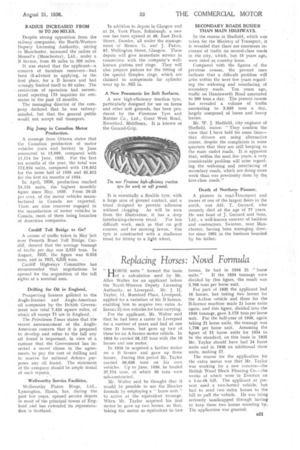Replacing Horses: Novel Formula
Page 35

If you've noticed an error in this article please click here to report it so we can fix it.
" HORSE units " formed the basis 1 lof a calculation used by Mr. Allen Walter for an applicant before the North-Western Deputy Licensing Authority, at Liverpool, Mr. J. II. Taylor, 11, Rumford Place, Liverpool, applied for a variation of his B licence, enabling him to acquire two extra Alicence 2i-ton vehicles for local carrying.
For the applicant, Mr. Walter said that he had been a carter in Liverpool for a number of years and had at one time 21 horses, but gave up two of these for an A-licence motor vehicle. In 1934 he carried 58,127 tons with the 19 horses and one motor.
In 1935 he acquired a further motor on a B licence and gave up three horses. During this period Mr. Taylor carried 66,636 tons on his own vehicles. Up to June, 1936, he hauled 37,774 tons, of which 39 tons were sub-contracted
Mr. Walter said he thought that it would be possible to use the Hawker formula by employing a " horse unit " to arrive at the equivalent tonnage. When Mr. Taylor acquired his first motor he gave up two horses, so that, taking the motor as equivalent to two horses, he had in 1934 21 " horse
units.." If the 1934 tonnage were divided by this figure, the result was 2,768 tons per horse unit.
For part of 1935 the applicant had 16 horses, but taking two horses for the A-class vehicle and three for the B-licence machine made 21 horse units again, and this figure, divided into the 1935 tonnage, gave 3,173 tons per horse unit. For the half-year of 1936, again taking 21 horse units, the tonnage was 1,798 per horse unit. Assuming the figure of 21 horse units for 1934 to be the standard, on this basis in 1935 Mr: Taylor should have had 24 horse units and in 1936 an additional three units, making 27.
The reason for the application for the extra motor was that Mr. Taylor was working for a new concern—the British Wood Block Flooring Co.—the works of which were in Everton on a 1-in-18 hill. The applicant at present used a two-horsed vehicle, but had to send two extra horses to the hill to pull the vehicle. He was being seriously handicapped through having to keep these two horses standing by. The application was granted.




























































































